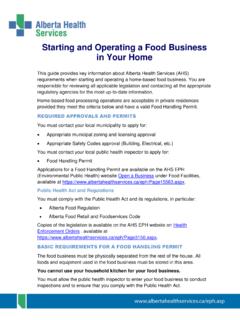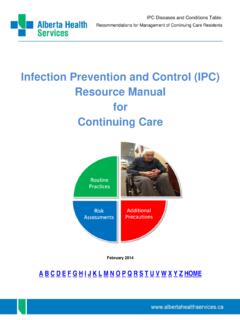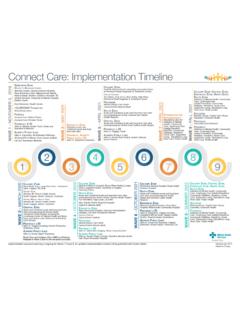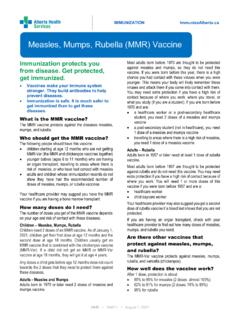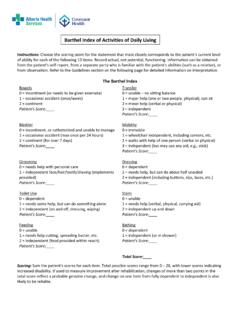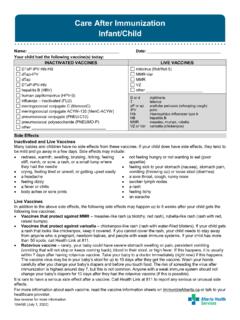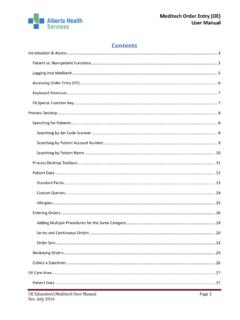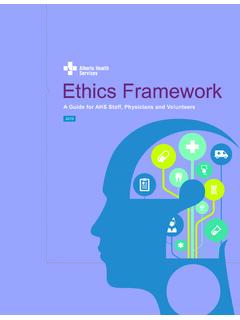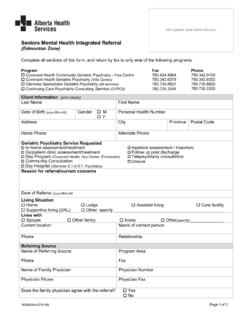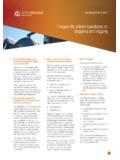Transcription of 07.280 Meningococcal Conjugate (Group C) Vaccine ...
1 Alberta Health Services Standard # September 5, 2018 Immunization Program Standards Manual Page 1 of 4 Population, Public and Indigenous Health Meningococcal Conjugate (Group C) Vaccine Biological Page Section 7: Biological Product Information Standard #: Created by: Province-wide Immunization Program Standards and Quality Approved by: Province-wide Immunization Program, Standards and Quality Approval Date: March 29, 2012 Revised: September 5, 2018 NeisVac-C Menjugate Manufacturer Pfizer Canada Inc GlaxoSmithKline Inc.
2 Biological Classification Inactivated Conjugate Indications for use of provincially funded Vaccine Pre-exposure: Infants and children 2 months up to and including 59 months of age Notes: Infants and children at high risk due to underlying medical conditions as defined below should receive Meningococcal quadrivalent Conjugate Vaccine groups A,C,Y and W-135 (MenC-ACYW) rather than Meningococcal Conjugate group C Vaccine (MenconC). Vaccine product used is dependent on age. See Meningococcal Conjugate (Groups A, C, Y and W-135) Vaccine Biological Page # Underlying medical conditions (use MenC-ACYW rather than MenconC): o Anatomical or functional asplenia (including sickle-cell disease).
3 O Complement, properdin, factor D or primary antibody deficiency or hypogammaglobulinemia o Acquired complement deficiency ( , due to receipt of the terminal complement inhibitor eculizumab [Soliris ]) o Hematopoietic stem cell transplant (HSCT) recipients o Solid organ transplant (SOT) candidates and recipients o HIV positive with no contraindication to immunization. For individuals who have previously received Meningococcal Conjugate (Groups A, C, Y and W-135) Vaccine , the dose(s) can be counted toward the routine Meningococcal C Conjugate Vaccine series.
4 Meningococcal Conjugate C Vaccine (MenconC) is not recommended in addition to Menveo for infants and children at high risk of invasive Meningococcal disease. Post-exposure: Immunization or re-immunization of close contacts of laboratory-confirmed cases of serogroup C invasive Meningococcal disease (IMD). See scheduling information for further details. o Results of index case serogrouping should be known (generally within 2 to 5 days) before proceeding with immunization. Outbreak control of laboratory-confirmed serogroup C invasive Meningococcal disease in consultation with zone Medical Officers of Health For disease information, contact assessment and reporting guidelines refer to Public Health Notifiable Disease Management Guidelines Meningococcal Disease, Invasive.
5 schedule Pre-Exposure: Dose 1 4 months of age Dose 2 12 months of age or older and at least 4 weeks after dose 1 Spacing Considerations: o Children beginning immunization at 12 months of age or older require only 1 dose before the 5th birthday. o Children who receive 1 dose prior to 12 months of age require 1 dose at 12 months of age or older and at least 4 weeks after the first dose. o Reinforcing doses of MenconC Vaccine are not considered necessary at Alberta Health Services Standard # September 5, 2018 Immunization Program Standards Manual Page 2 of 4 Population, Public and Indigenous Health NeisVac-C Menjugate present.
6 O For individuals who have previously received the Meningococcal polysaccharide Vaccine there should be at least a 6 month interval before administering MenconC. Post-exposure for contact of confirmed serogroup C Meningococcal disease cases: 2 months up to and including 11 months of age: o Unimmunized: administer 1 dose o Previous immunization: administer 1 dose if at least 4 weeks since previous dose. 12 months of age and older: o Unimmunized: administer 1 dose. o Previously immunized at younger than 12 months of age or at high risk due to an underlying medical condition: administer 1 dose if at least 4 weeks since the last dose.
7 O Previously immunized at 12 months of age or older: administer 1 dose if at least 1 year since the last dose. Note: Use MenC-ACYW post-exposure for Meningococcal C if the individual is eligible for the MenC-ACYW Vaccine ( a student in Grades 9, 10, 11 or 12 who has not already received their adolescent dose of MenC-ACYW Vaccine ). Preferred Use There will be no preference indicated for the use of Meningococcal Conjugate group C Vaccine in specific age or risk groups. Both vaccines are safe and immunogenic in individuals two months of age and older.
8 Persons with medical contraindications to one product should be offered the alternate product if supply is available. Dose mL Route Intramuscular Contraindications/ Precautions Contraindications Known severe hypersensitivity to any component of the Vaccine Anaphylactic or other allergic reactions to a previous dose of Vaccine containing Meningococcal Conjugate C antigen Precautions Premature and very low birthweight infants ( , 1500 g) still hospitalized at the time of immunization may experience a transient increase or recurrence of apnea and bradycardia following immunization.
9 This subsides within 48 hours and does not alter the overall clinical progress of the child. The risk of these events is greater among infants with ongoing cardiorespiratory issues at the time of immunization, but such events can also occur in those who are clinically stable. Given these findings, it is recommended that hospitalized premature infants have continuous cardiac and respiratory monitoring for 48 hours after their first immunization. Possible Reactions Common: Redness, swelling, induration and/or pain at injection site.
10 Headache and fever, drowsiness and somnolence or impaired sleeping, myalgia in the arms or legs. Anorexia, vomiting, nausea or diarrhea; crying and irritability (infants and/or toddlers) Rare: Relapse of nephrotic syndrome has been reported to present within a few months following immunization. Anaphylaxis, allergic reaction. Lymphadenopathy, idiopathic thrombocytopenic purpura, dizziness, convulsions including febrile, faints, rash, urticaria, pruritus, erythema multiforme, Stevens-Johnson Syndrome, arthralgia, hypoaesthesia, paraesthesia and hypotonia in infants.
